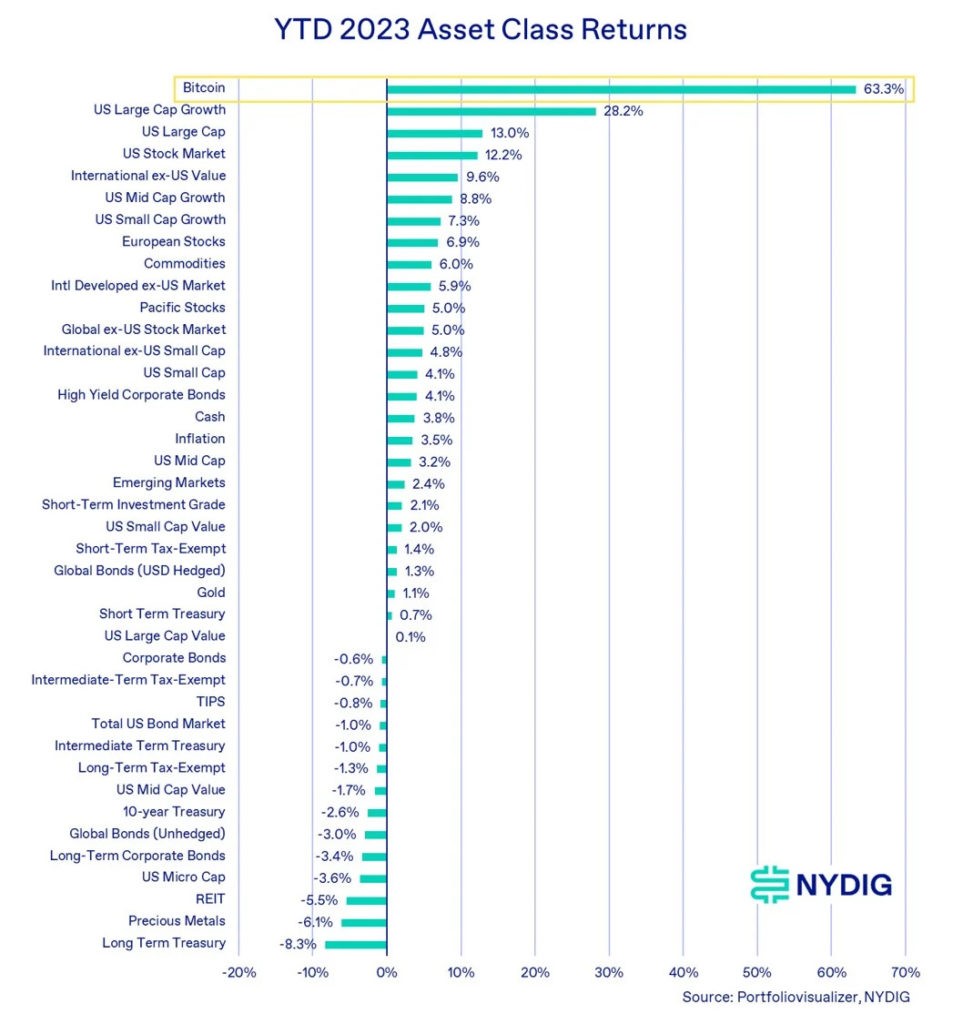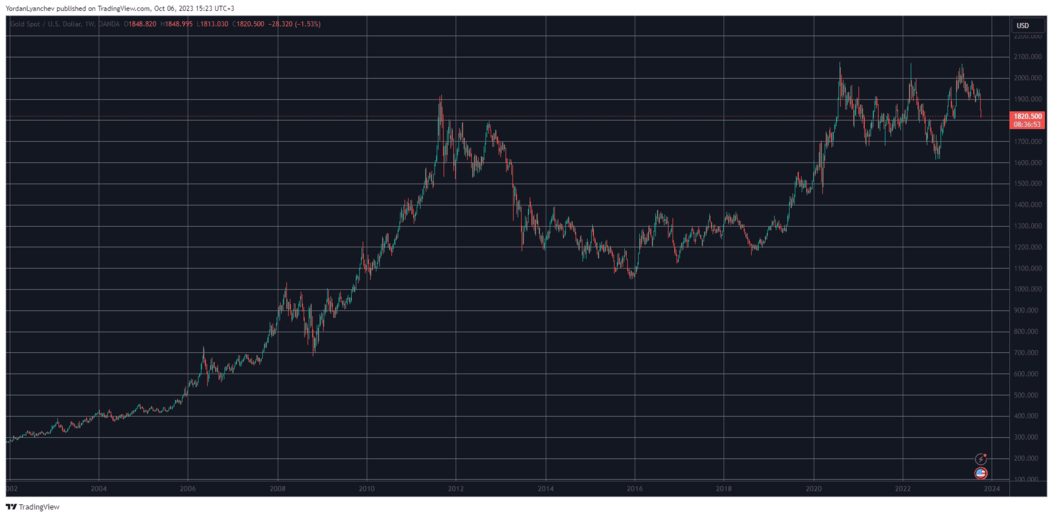
In a year filled with economic destabilization, persistently high inflation, and concerns about rising interest rates, Bitcoin continued to grow and outperform other traditional asset classes. The crypto king’s performance has been remarkable even though its price has largely traded in consolidation.
In particular, Bitcoin emerged as the top-performing asset class in 2023, with a 63.3% gain, leading among 40 selected asset classes, according to data released by NYDIG on June 6 . ten.
Among these assets, the second best performers were shares of large-cap companies in the U.S. market, up 28.2%. Meanwhile, Bitcoin outperformed other notable assets, including the US stock market (12.2%), commodities (6%), cash (3.8%), and gold (1 ,first%).

Returns of asset types from the beginning of 2023 to present | Source: NYDIG
One of the most striking aspects of Bitcoin’s performance this year has been its ability to maintain a relatively narrow trading range despite significant external pressure. The top cryptocurrency by capitalization held in the $25,000 to $31,000 range, resolutely resisting breakout attempts in either direction. Notably, year-to-date gains have been maintained, although Bitcoin slowed in the third quarter, when the asset fell 11.1%.
According to the report, that stability has been maintained despite a series of events, including court rulings, macroeconomic changes, government shutdown concerns, debate over the debt ceiling and others. ongoing efforts to gain approval for a Bitcoin spot exchange-traded fund (ETF) in the United States.
Potential factors driving Bitcoin price increaseHowever, the report authors claim Bitcoin still has upside potential, thanks to several driving factors.
“However, it is important to acknowledge Bitcoin is largely driven by idiosyncratic factors. Looking ahead, we are optimistic for key industry developments, such as the potential launch of spot ETFs and the upcoming halving, which will play a more prominent role in driving the value of Bitcoin in the future,” the report said.
Meanwhile, the market is closely watching potential price levels that could signal the start of a bull market. According to the report, Bitcoin needs to maintain bull market support at $24,900.
Besides the ETF news, analysts are also looking at near-term catalysts that could fuel a short-term rally, such as a significant deviation from the gains in the jobs report.
Specifically, the US Bureau of Labor Statistics reported adding 336,000 jobs in September, surpassing economists’ forecast of only 170,000. The unemployment rate remained unchanged at 3.8%, despite forecasts for a fall to 3.7%. While this development initially caused Bitcoin’s price to drop slightly, the asset has made some gains since then.
Gold vs BitcoinIs gold still considered the most suitable hedge investment tool or has that strong belief disappeared?
Since the concept of investment existed, gold has been one of the most popular investment tools for preserving asset prices. This is due to gold’s unique characteristics such as limited supply (scarcity) and no central governing authority governing its creation. However, gold’s performance on a weekly, annual and even 10-year scale has not been so impressive.
Meanwhile, BTC is a much newer concept, taking the unique properties of gold to a new level. And, although it has its own drawbacks, it’s been working much better lately.
As a less volatile and risky asset, gold price performance often increases sharply during periods of economic uncertainty. This could be seen during and mainly after several previous global financial crises, including the one from 2008. The precious metal skyrocketed to new peaks a few years later but never got close to the coveted $2,000 mark.
The next eight years (2012-2020) were one of the most prosperous periods in terms of global economic growth, leading to skyrocketing prices of risky assets, such as stocks and Bitcoin.
During this time frame, gold disappeared from investors’ vocabulary and its price fell from over $1,900 to less than $1,100 during its worst days. But when Covid-19 shocked the world, gold exploded due to a new wave of economic instability.
The same thing happened again when the Russia-Ukraine “special military operation” (in other words, war) broke out. The end of speculation by the US government and the country’s inability to pay its debts led to similar developments.
However, the past few weeks have been particularly difficult for bullion, with prices down 7% (over $130). Its price against the dollar is already quite solid (relative to other currencies), at $1,820 as of Friday’s close. This leads to some compelling conclusions: 1) gold lost all of its annual gains in the latest price drop and 2) the metal is now valued lower than it was more than a decade ago when it peaked after the 2008 banking crisis.
At the same time, it should come as no surprise to anyone that the dollar has lost massive amounts of purchasing power, especially in the wake of the pandemic and after multiple extraordinary bailouts (i.e. staggering amounts of greenbacks). printed and sent to everyone to resolve suspicious reasons).

XAU/USD weekly | Source: TradingView
Therefore, the question is whether gold is still a safe haven investment asset or not. Also, is gold’s performance still linked to US interest rates?
Bart Melek, head of commodity strategy at TD Securities, said:
“The whole story of keeping interest rates higher for longer is the main reason people are taking their positions out of gold because the opportunity cost of holding it has gone up.”
What about Bitcoin?So gold’s performance against the US dollar was quite impressive until around 2012, when it peaked above $1,900, as it did during previous major economic crises. But how has the landscape changed?
While there may be a number of reasons why gold appears to no longer serve as a safe haven, perhaps the most central of these is the existence of Bitcoin. The flagship cryptocurrency created during the aforementioned 2008 banking crisis, carries a message designated for the billions and trillions of fiat currency printed at that time in its original code and also contains many properties of gold but also takes them to a completely different level.
While also scarce (but with proven scarcity, unlike gold), Bitcoin lacks a central governing authority that could increase the amount in circulation for reasons that only Satoshi Nakamoto himself just know. At the same time, Bitcoin is also censorship-resistant, accessible, non-discriminatory, and digital.
It is this digital nature that has made Bitcoin especially lucrative during the pandemic when the world shut down, limiting gold production and transportation. People cannot get their hands on physical gold. Because BTC is completely digital, transfers take just a few minutes and usually cost very little.
BTC’s price performance was quite spectacular and volatile until 2020 but skyrocketed in the year after the pandemic and jumped from $8,000 to $69,000.
Although 2022 brings a completely different mentality, due to the ongoing war, industry collapse and rising interest rates, the network is still performing well across the board. 2023 has also been quite positive so far, with the number of BTC transactions 65% higher than on January 1, unlike the precious metal gold.
Of course, it would be considered quite arrogant and perhaps incorrect to suggest that BTC has overtaken gold as the most preferred hedge against inflation and economic instability. However, this asset class will find a place among gold’s notable successors or alternatives, as many financial experts and prominent investors have asserted over the past few years.
Source:
https://tradecoind2.com/bitcoins-best-performer-of-2023-beating-40-global-assets/ .
.  .
.  .
.  .
.  .
.  .
.  .
.  Shop
Shop
